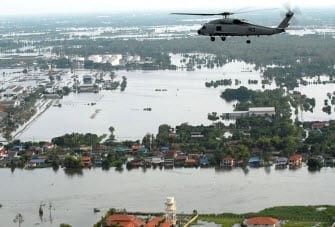 BOSTON, Nov. 9, 2011 – According to catastrophe modeling firm AIR Worldwide, historic flooding in Thailand continues to damage residential properties and has interrupted operations for numerous businesses. At the start of this year’s monsoon season in late July, Tropical Storm Nock-Ten brought high precipitation levels that swelled the Yom and Nan rivers in the north of Thailand, forcing the evacuation of 650,000 people. Since then, persistently heavy rains have caused serious flooding throughout the country, killing more than 500 people and severely affecting an estimated 2.5-3 million more in what has been the most severe floods in 50 years for the region. Current predictions are divided as to whether the defenses protecting central Bangkok, including the main business district, will hold over the coming days. Also, the long-term economic impact of this event is set to be far reaching and no reliable estimates can yet be made as to the impact the flooding will have on the global economy. The Bank of Thailand has cut their projected 2011 national economic growth forecast from 4.1% down to 2.6%.
BOSTON, Nov. 9, 2011 – According to catastrophe modeling firm AIR Worldwide, historic flooding in Thailand continues to damage residential properties and has interrupted operations for numerous businesses. At the start of this year’s monsoon season in late July, Tropical Storm Nock-Ten brought high precipitation levels that swelled the Yom and Nan rivers in the north of Thailand, forcing the evacuation of 650,000 people. Since then, persistently heavy rains have caused serious flooding throughout the country, killing more than 500 people and severely affecting an estimated 2.5-3 million more in what has been the most severe floods in 50 years for the region. Current predictions are divided as to whether the defenses protecting central Bangkok, including the main business district, will hold over the coming days. Also, the long-term economic impact of this event is set to be far reaching and no reliable estimates can yet be made as to the impact the flooding will have on the global economy. The Bank of Thailand has cut their projected 2011 national economic growth forecast from 4.1% down to 2.6%.
According to AIR, upwards of three quarters of a million residential properties are reported to have been damaged or destroyed by the flooding. However, Thailand’s General Insurance Agency (GIA) estimates that less than 1% of residential properties are insured for flood damage. The government has set aside an initial budget of THB 100 billion (USD 3.3 billion) to begin the rebuilding process. Infrastructure and transport links have also been heavily affected, although Bangkok’s sky-train and subway have not been damaged. In addition, power outages, a shortage of food, and concerns about sanitation complicate recovery efforts in the affected areas.
The major cost of the flooding, however, is a result of disruption to manufacturing and supply chains. Reports suggest that up to seven industrial estates, housing close to 1000 manufacturing plants and employing approximately 460,000 people, have been out of use for weeks now. Some companies are estimating it will take up to six weeks to restart production, while others are considering not re-opening. Flood insurance is prevalent in these industrial parks and the brunt of this loss will be borne by the insurance industry.
Two particularly hard hit sectors are the automobile and computer manufacturing industries. Two of the world’s largest car manufacturers, Honda and Toyota, have had severe disruption to their manufacturing processes, not just in Thailand but worldwide, due to a lack of parts. Thailand is responsible for the manufacturing of about a quarter of all HDD drives produced for the global computing industry. This round of flooding has raised fears of a global supply shortage of hard disk drives in the run-up to the lucrative Christmas period; already prices of hard drives are reported to have increased by up to 180%.
According to AIR, the recent flooding has been described as among the worst in Thailand’s history, with some 6 million hectares of land affected. In the north and central plains, the damage has been predominantly to residential properties and to agriculture. Rice paddies in particular have been quite hard hit, with reports of over 10% having been destroyed. A contributing factor to the severity of flooding in Southeast Asia this year is the appearance of a weak La Niña phenomenon. La Niña, which is one phase of the El Niño Southern Oscillation (ENSO) climate pattern, creates conditions that are conducive to heavy precipitation and flooding in this region. Accumulated monthly rainfall totals in August and September exceeded 300 mm in vast portions of the country, reaching more than one meter in some isolated areas. In October, more than 200-400 mm of precipitation fell in parts of central Thailand, exacerbating the flooding situation in Bangkok.
Flooding was at first confined to the north and northeast of the country but has steadily moved further into the central plains. As the monsoon season continued, the Bhumibol and Sirikit dams in northern Thailand reached their capacity, forcing authorities to increase their discharge rates at the start of October. This further raised water levels downstream in the southern central plain and into Bangkok. Failure of flood barriers in the north of the city and the continued accumulation of floodwaters from the north, having been backed up by a period of high tide, has meant that flooding to some districts in the capital was unavoidable. As of November 7, 12 of the 50 districts of the capital were on the evacuation list with a further 7 sub-districts on partial notice. The commercial heart of the city, however, remains dry at present. Officials estimate that flood conditions in the Bangkok area are likely to continue for several more weeks.
AIR continues to monitor the situation and will provide information if changes occur.
